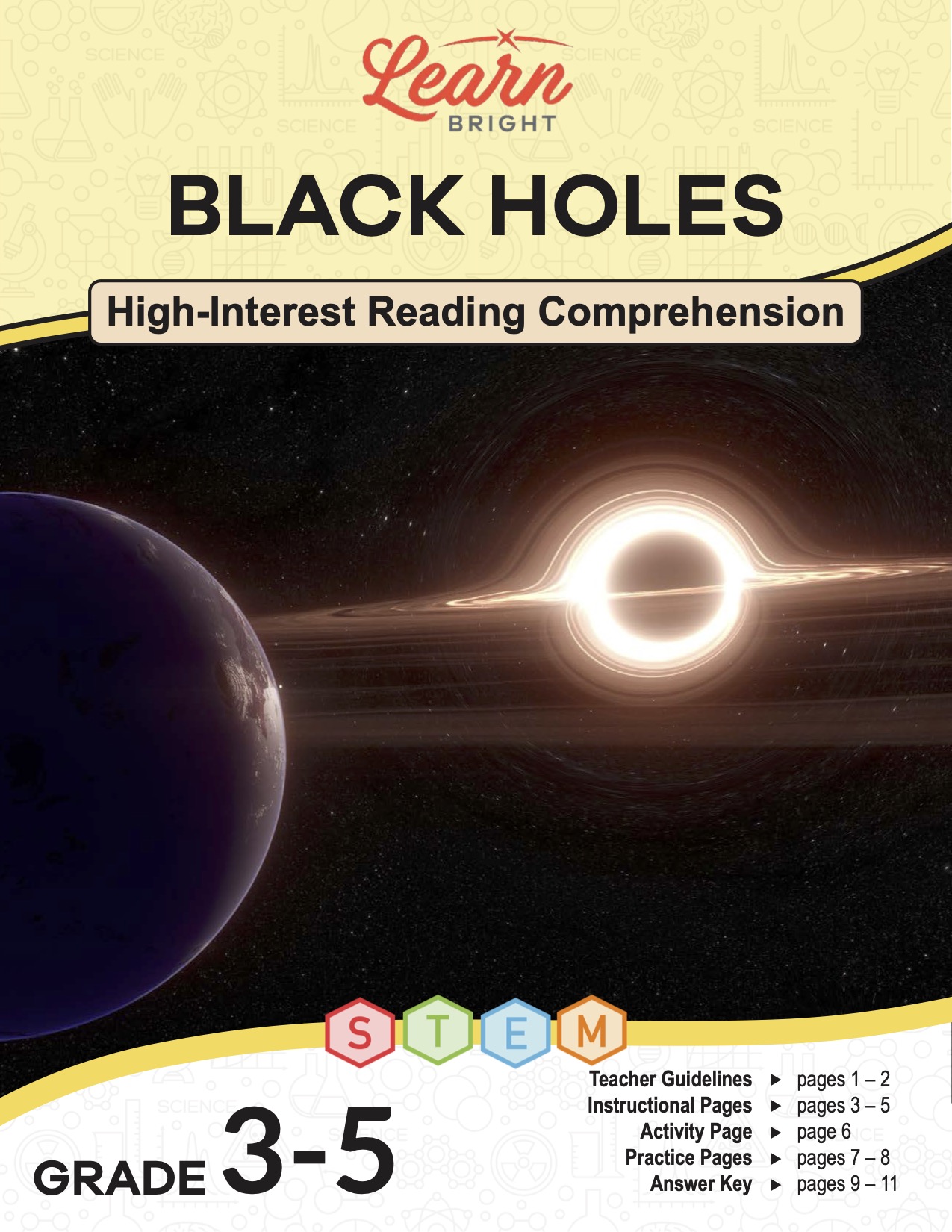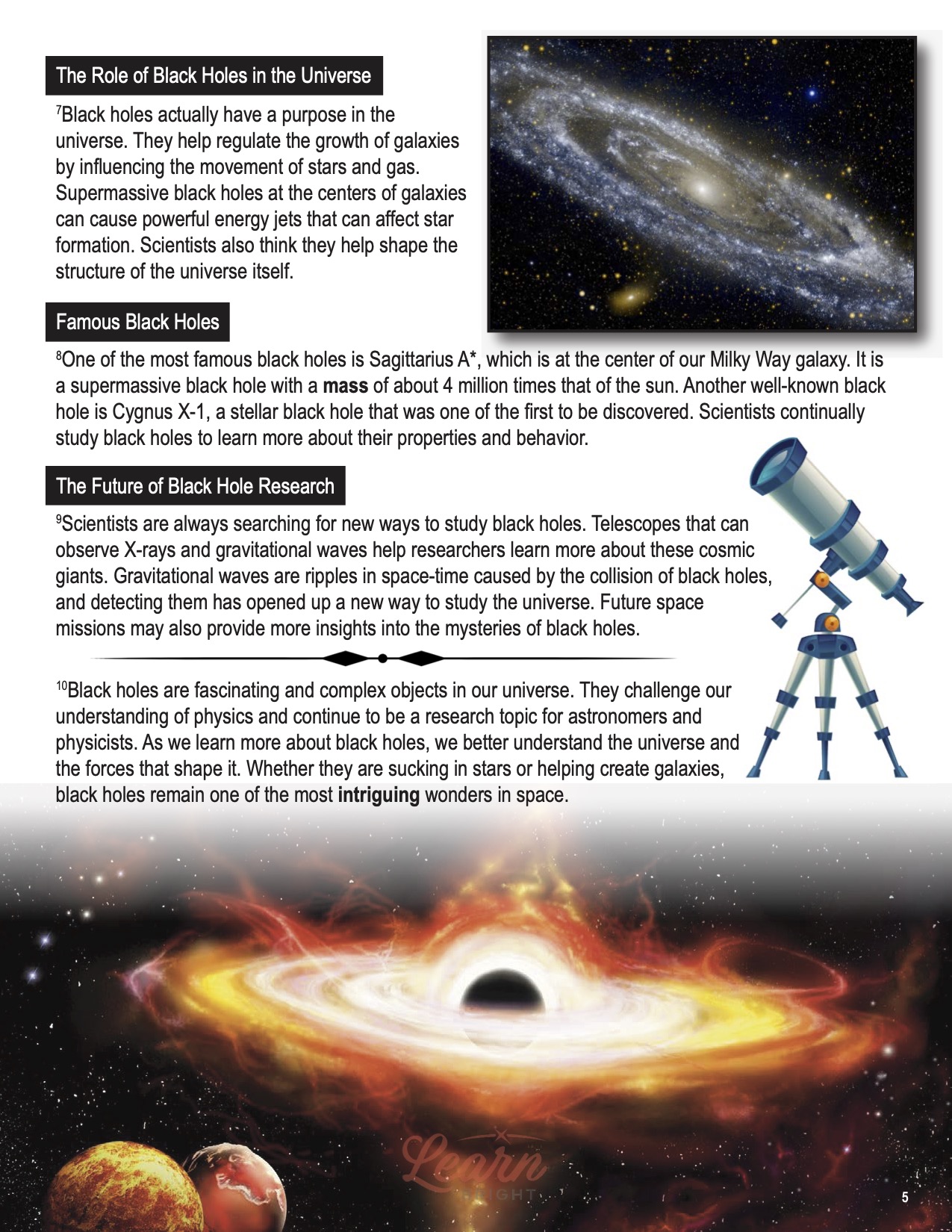Description
What our Black Holes STEM lesson plan includes
Lesson Objectives and Overview: Black Holes STEM is a high-interest reading comprehension lesson plan. As such, students will practice various close reading and comprehension skills. In addition, they will determine the central idea or theme of the article and understand more about black holes. This lesson is for students in 3rd grade, 4th grade, and 5th grade.
Classroom Procedure
Every lesson plan provides you with a classroom procedure page that outlines a step-by-step guide to follow. You do not have to follow the guide exactly. The guide helps you organize the lesson and details when to hand out worksheets. It also lists information in the yellow box that you might find useful. You will find the lesson objectives, state standards, and number of class sessions the lesson should take to complete in this area. In addition, it describes the supplies you will need as well as what and how you need to prepare beforehand. During the activity, each group of students will need one balloon, several sheets of aluminum foil, and a pin.
Teacher Notes
The paragraph on this page gives you a little more information on the lesson overall and describes what you may want to focus your teaching on. It explains that you can teach this lesson in a whole-class setting or as an independent, small-group activity. The blank lines are available for you to write out any thoughts or ideas you have as you prepare.
BLACK HOLES STEM LESSON PLAN CONTENT PAGES
Introduction to Black Holes
The Black Holes STEM lesson plan contains three content pages. A black hole is a strange space where gravity is so strong that nothing, not even light, can escape. It’s like a giant vacuum cleaner that sucks up everything around it! Black holes are made when massive stars reach the end of their lives and collapse. This collapse creates a tiny, super-dense point called a singularity, surrounded by an event horizon. The event horizon is like a one-way door—once something goes through, it can’t come back out.
To understand how black holes form, we first need to learn about stars. Like our sun, stars are enormous balls of gas that produce light and heat through nuclear fusion. When a star runs out of fuel, it can no longer support itself against the pull of gravity. For small to medium-sized stars, this leads to a process called a supernova, where the outer layers explode, leaving behind a core that can become a neutron star or a black hole if it is massive enough.
There are three main types of black holes: stellar black holes, supermassive black holes, and intermediate black holes. Stellar black holes are formed from dying stars and can be about 20 times more massive than the sun. Supermassive black holes are found at the centers of galaxies. They can be millions or even billions of times more massive than the sun! (Remember, mass isn’t the same as size. Some black holes, despite a great mass, are the size of a single atom.) Intermediate black holes are less common and are thought to form when stars in a star cluster collide.
Logistics of Black Holes
Since black holes do not emit light, scientists cannot see them directly. Instead, they look for their effects on nearby objects. When a black hole pulls in material from a companion star, it creates a disk of gas and dust that heats up and emits X-rays. By detecting these X-rays, astronomers can identify the presence of a black hole. They can also observe how stars move around the black hole, which helps them determine its mass.
The event horizon is the boundary around a black hole beyond which nothing can escape. It is not a physical surface but rather a point where the escape velocity exceeds the speed of light. For example, if you were to fall into a black hole, you could no longer communicate with the outside universe once you crossed the event horizon. It would be like entering a one-way tunnel that leads to a dark and mysterious place.
The inside of a black hole remains a mystery. According to current theories, it is pulled toward the singularity once something crosses the event horizon. However, scientists still don’t fully understand what happens to matter at this point. Some think that in the extreme environment of a black hole, the laws of physics—like gravity, time, and how objects move—might stop working the way they usually do.
Why Do They Exist?
Black holes actually have a purpose in the universe. They help regulate the growth of galaxies by influencing the movement of stars and gas. Supermassive black holes at the centers of galaxies can cause powerful energy jets that can affect star formation. Scientists also think they help shape the structure of the universe itself.
One of the most famous black holes is Sagittarius A*, which is at the center of our Milky Way galaxy. It is a supermassive black hole with a mass of about 4 million times that of the sun. Another well-known black hole is Cygnus X-1, a stellar black hole that was one of the first to be discovered. Scientists continually study black holes to learn more about their properties and behavior.
Scientists are always searching for new ways to study black holes. Telescopes that can observe X-rays and gravitational waves help researchers learn more about these cosmic giants. Gravitational waves are ripples in space-time caused by the collision of black holes, and detecting them has opened up a new way to study the universe. Future space missions may also provide more insights into the mysteries of black holes.
Black holes are fascinating and complex objects in our universe. They challenge our understanding of physics and continue to be a research topic for astronomers and physicists. As we learn more about black holes, we better understand the universe and the forces that shape it. Whether they are sucking in stars or helping create galaxies, black holes remain one of the most intriguing wonders in space.
BLACK HOLES STEM LESSON PLAN WORKSHEETS
The Black Holes STEM lesson plan includes two worksheets: an activity worksheet and a practice worksheet. Each one will help students solidify their grasp of the material they learned throughout the lesson. You can refer to the classroom procedure guidelines to know when to hand out each worksheet.
BLACK HOLE MODEL ACTIVITY WORKSHEET
For the activity, students will create simple models of a black hole using balloons and aluminum foil. You will divide students into small groups to complete the activity. Students will then follow the steps on the page to create their models. Afterward, there are discussion questions for students to talk about when they finish their models. You can use the “answer key” as a guide when discussing the questions with students.
BLACK HOLES STEM PRACTICE WORKSHEET
The practice worksheet lists 10 questions based on the content. These questions all relate to the content pages, so students will need to refer to them often for the answers. In addition, each question provides which reading tool the question corresponds to, such as text feature, vocabulary, or comprehension.
Worksheet Answer Keys
At the end of the lesson plan document is an answer key for the practice worksheet. The correct answers are all in red to make it easier for you to compare them with students’ responses. If you choose to administer the lesson pages to your students via PDF, you will need to save a new file that omits these pages. Otherwise, you can simply print out the applicable pages and keep these as reference for yourself when grading assignments.









